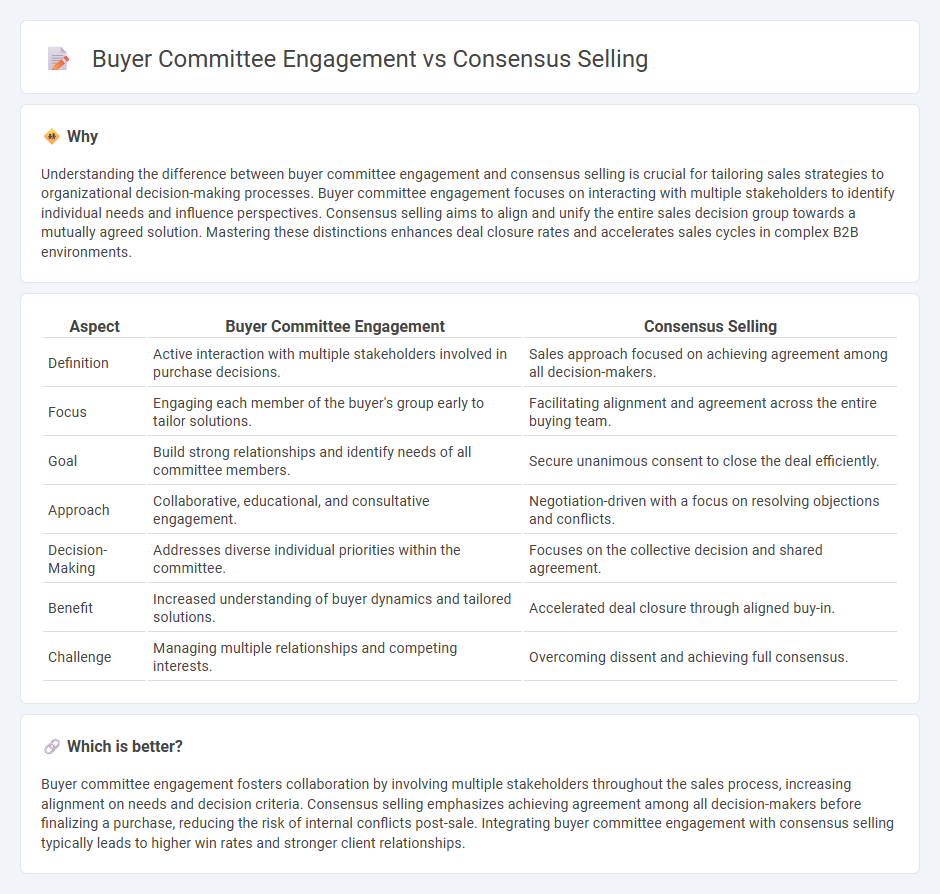
Buyer committee engagement focuses on actively involving all decision-makers in the purchasing process to address diverse needs and ensure alignment, whereas Consensus Selling emphasizes building agreement among stakeholders through collaborative discussions and shared objectives. Effective buyer committee engagement drives tailored communication and strategic collaboration, leading to streamlined decision-making and higher conversion rates. Discover how adopting these approaches can transform your sales strategy and boost deal success.
Why it is important
Understanding the difference between buyer committee engagement and consensus selling is crucial for tailoring sales strategies to organizational decision-making processes. Buyer committee engagement focuses on interacting with multiple stakeholders to identify individual needs and influence perspectives. Consensus selling aims to align and unify the entire sales decision group towards a mutually agreed solution. Mastering these distinctions enhances deal closure rates and accelerates sales cycles in complex B2B environments.
Comparison Table
| Aspect | Buyer Committee Engagement | Consensus Selling |
|---|---|---|
| Definition | Active interaction with multiple stakeholders involved in purchase decisions. | Sales approach focused on achieving agreement among all decision-makers. |
| Focus | Engaging each member of the buyer's group early to tailor solutions. | Facilitating alignment and agreement across the entire buying team. |
| Goal | Build strong relationships and identify needs of all committee members. | Secure unanimous consent to close the deal efficiently. |
| Approach | Collaborative, educational, and consultative engagement. | Negotiation-driven with a focus on resolving objections and conflicts. |
| Decision-Making | Addresses diverse individual priorities within the committee. | Focuses on the collective decision and shared agreement. |
| Benefit | Increased understanding of buyer dynamics and tailored solutions. | Accelerated deal closure through aligned buy-in. |
| Challenge | Managing multiple relationships and competing interests. | Overcoming dissent and achieving full consensus. |
Which is better?
Buyer committee engagement fosters collaboration by involving multiple stakeholders throughout the sales process, increasing alignment on needs and decision criteria. Consensus selling emphasizes achieving agreement among all decision-makers before finalizing a purchase, reducing the risk of internal conflicts post-sale. Integrating buyer committee engagement with consensus selling typically leads to higher win rates and stronger client relationships.
Connection
Buyer committee engagement enhances Consensus Selling by fostering collaboration among multiple decision-makers, ensuring alignment on requirements and priorities. Active participation from various stakeholders in the buyer committee improves transparency and accelerates agreement on purchase decisions. Consensus Selling relies on this collective input to address objections and tailor solutions, ultimately driving higher conversion rates and shorter sales cycles.
Key Terms
Stakeholder Alignment
Consensus selling emphasizes achieving agreement among all stakeholders to ensure unified decision-making, reducing potential conflicts during the sales process. Buyer committee engagement involves actively involving diverse committee members to address their specific concerns, fostering collaboration and tailored communication. Explore strategies to enhance stakeholder alignment and drive successful outcomes in complex sales environments.
Decision-Making Unit (DMU)
Consensus selling involves uniting all stakeholders within a Decision-Making Unit (DMU) to achieve a collective agreement on purchasing decisions, emphasizing collaboration and alignment of diverse interests. Buyer committee engagement targets active involvement and influence over individual committee members to shape preferences and address concerns throughout the decision process. Explore more on how leveraging DMU dynamics enhances sales strategies and buyer committee effectiveness.
Multi-threading
Consensus selling emphasizes aligning multiple stakeholders' interests within an organization to secure buy-in, leveraging collaborative decision-making to address diverse concerns. Buyer committee engagement centers on interacting with various decision-makers simultaneously, utilizing multi-threading strategies to build relationships across departments and mitigate risks of stalled deals. Explore effective multi-threading techniques to enhance consensus selling and ownership collaboration for better sales outcomes.
Source and External Links
Sell Better By Building Consensus - Summit Learning Systems - Consensus selling is a powerful strategy where salespeople engage all stakeholders in the decision-making process to build trust and tailored solutions, especially important in enterprise sales to avoid delays and foster long-term relationships.
Consensus Sales: 9 tips for building buying consensus - Consensus selling focuses on aligning the entire buying committee by identifying stakeholder pain points and collaboratively mapping solutions to satisfy the whole team rather than just convincing a single decision-maker.
6 Strategies to Build Consensus in the Sales Process - Consensus building in sales involves guiding complex buying teams through identifying the problem, agreeing on the process, and selecting the solution provider while addressing each decision-maker's concerns to unify the group around common goals.
 dowidth.com
dowidth.com